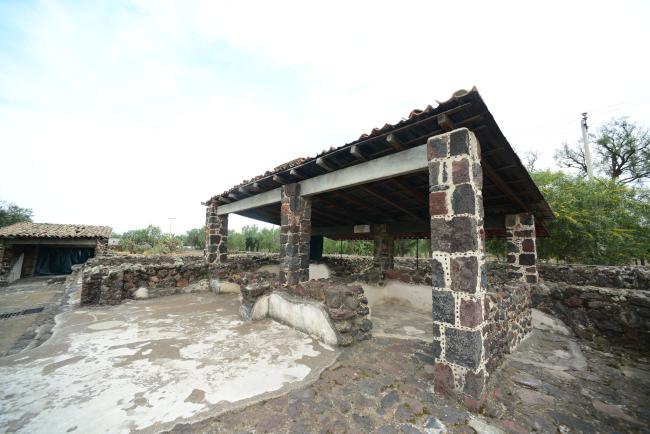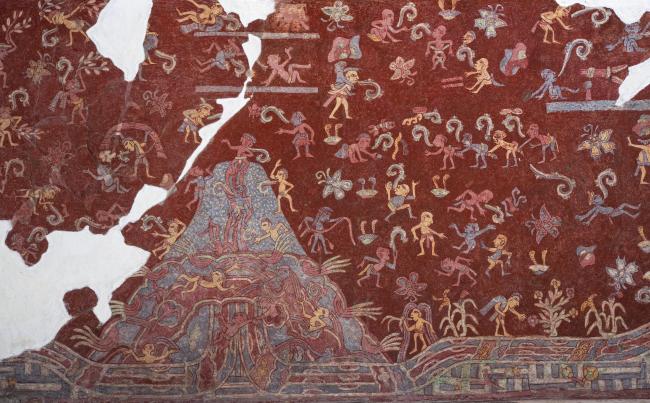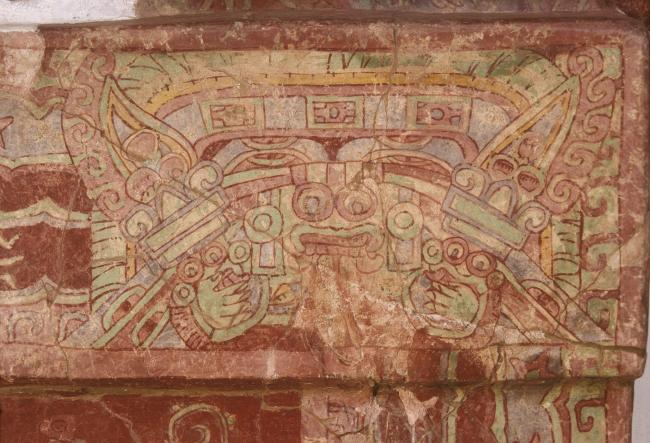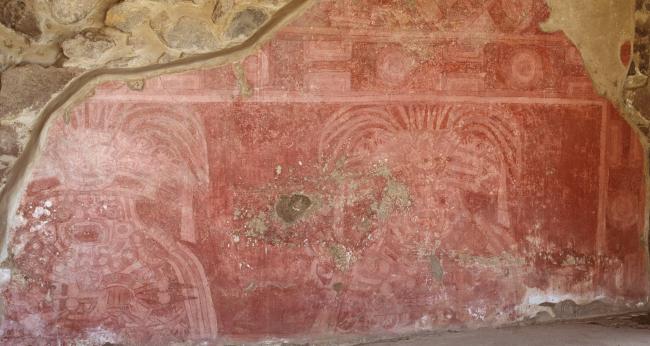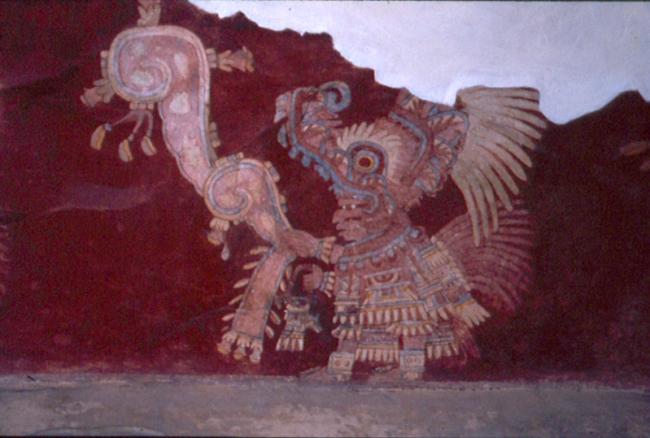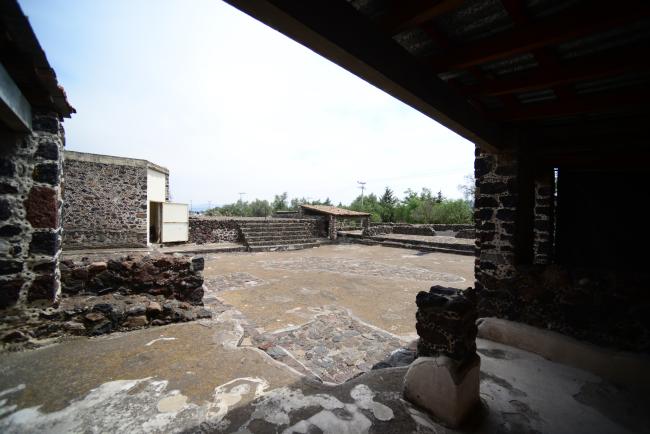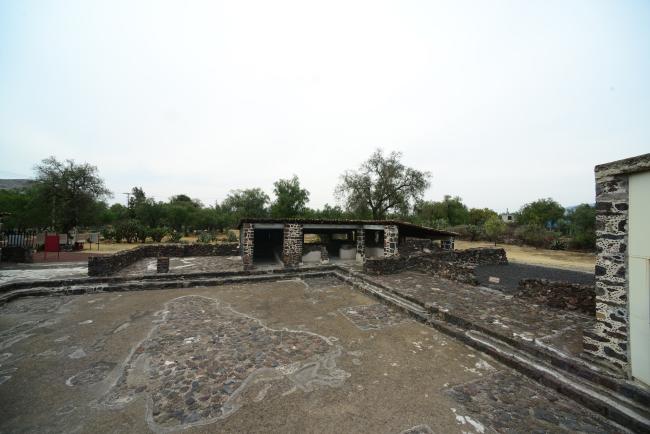
Tepantitla
Estructura
This complex, located on the east side of the Teotihuacan ceremonial center, was inhabited by a priestly house or by a family of high social hierarchy. Although it is not fully explored, it has a mural alluding to the cosmovision of the Teotihuacan society. The murals of the Red Tlalocan, the Tlalocan or paradise of Tlalocan and a procession of warrior-priests stand out.
Tlalocan: This slope is the one that has given its explanation to the whole chamber, called Tlalocan by Alfonso Caso; symbols associated to the ball game and sacrifice proliferate, it is the only one where butterflies appear. It is the visual axis of the composition, the mountain from which water descends and is located exactly below the ball game; from its sides and upwards, it can be seen that all the human figures are paired. The importance of the finding of this wall lies in the confirmation of the practice of the ball game in Teotihuacan, in spite of not having found any court.
In the painting it is very clear the delimitation of the space for the celebration of the encounter, the markers are placed facing each other and with their bases towards the center; the event takes place in what could be two different teams that are identified because they wear different headdresses and clothing. The headdress of one looks like a thick band across the forehead with a projection projecting upward at the back; the other is a thinner band that is knotted at the forehead. Those who wear the thick band wear a kind of skirt with geometric designs and fringe; those with the thinner band wear only a maxtlatl.
Fuente, Beatriz de la (coord.), 1995, La pintura mural prehispánica en México Teotihuacán, volume I, Mexico, UNAM/IIE.
Mask of Tlaloc: The headdress is formed by three overlapping parallel stripes, from bottom to top; in the foreground is the widest and is decorated with three rectangular medallions that have a red inscribed cross, surrounded by green, with a blue center. Towards the top, the headdress is bordered by a border formed by yellow feathers and, surrounding it, another border of feathers, now green.
Between the base of the headdress and the head, as if it were his hair, sprout some jets of liquid, one red and one blue, separated by a thin white stripe, and they have eyes; his earflaps are formed by a circle and a trapezoid, the nose is delineated with red; in the mouth he carries a water lily of red stem; the green leaf, a yellow button and some like feathers in blue, red, green and yellow; the teeth and fangs are red. The masks lack body, only the hands are seen that are embracing what could be two vessels that duplicate the image, but with a different headdress, formed by a kind of conical cap bordered by a green list, a yellow one and the blue center, outlined all with red.
The center of the cone is decorated with three circles, perhaps shells, red, bordered in green, that are arranged like a pyramid, two below and one above; downwards another central element in form of cone is seen, and they finish it to the sides two volutes, that rest on a green rectangle delineated in blue; the hands are green, the red nails, and they have a fist of feathers that leave a green edge; later what could be their arm is in blue. The masks in profile have a headdress of green feathers that come out of a runner formed with concentric circles: the first one resembles green feathers, then a red one, a yellow one and the green center.
Fuente, Beatriz de la (coord.), 1995, La pintura mural prehispánica en México Teotihuacán, volume I, Mexico, UNAM/IIE.
Red Tlalocs: The red Tlaloc is a deity associated with war, which like many Teotihuacan figures is composed of various elements: some parts of the human body, others of animals and some more symbolic elements that make up an icon of difficult reading and interpretation.
Fuente, Beatriz de la (coord.), 1995, La pintura mural prehispánica en México Teotihuacán, volume I, Mexico, UNAM/IIE.
Sower priests: These are priests who form a procession that leaves from the southeast side, and continues on the south wall towards the east. They wear a helmet with the figure of a saurian, possibly a lizard or alligator; the headdress is topped with long feathers that fall toward the back of the individual; the feathers are held by a series of hooks from which a drop falls; they emerge from a strip that is yellow in the first one and blue in the others; this fringe frames another wider, red one, and at the same time these wrap another row of green feathers that surround the eye of the saurian; only the upper jaw of the animal is seen, which has the nose formed by a hook, and what would be its scales are similar to the hooks of the upper part of the headdress; from these also falls a drop; the fangs, teeth and molars are placed under a blue stripe; the last molar is seen on the fringe of the characters, whose eyes are decorated with a very tan red stripe, which is repeated on the cheek; also on the cheek a T-shaped design is observed, of lighter color; they have the mouth half open and part of the neck can be seen; a part of the red earflare with white is distinguished on the edge of the headdress.
The costume is finished off at the neck with a blue ribbon, and squares bordered by another blue stripe that is finished off with blue feathers or shells surrounded by two red inks; it is adorned with a kind of braids that end in a trapeze, as well as a breastplate integrated by a rectangle, in whose interior there is a figure similar to an eye, finished off by white and yellow blue designs; both the braids and the breastplate end with feathers; in the back it has a piece similar to the breastplate, only more elongated and from whose center come out red feathers.
The sandals are conformed with a rectangle with two inscribed circles, blue, a stripe of the same color and another square, also decorated with light blue circles; towards the foot it has some strips of the same color; from the right hand flow two currents: one upward in the form of scrolls, decorated with shells, animal heads, hands and chalchihuites; flowers and the step typical of the virgules alternate; the last scroll ends with a flower from which buds of Nymphaea mex emerge; and another straight stream downward; ovals are observed that have been interpreted as seeds and hence the name of the chamber; the flowers that ornament this stream are the same as those of the upper part. In the left hand he carries the bag decorated with different geometric designs and the animals seem to be felines and canids.
Fuente, Beatriz de la (coord.), 1995, La pintura mural prehispánica en México Teotihuacán, volume I, Mexico, UNAM/IIE.


